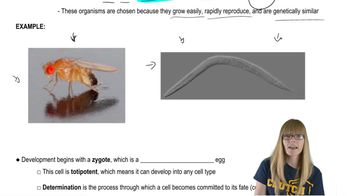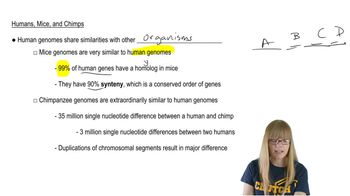Table of contents
- 1. Introduction to Genetics51m
- 2. Mendel's Laws of Inheritance3h 37m
- 3. Extensions to Mendelian Inheritance2h 41m
- 4. Genetic Mapping and Linkage2h 28m
- 5. Genetics of Bacteria and Viruses1h 21m
- 6. Chromosomal Variation1h 48m
- 7. DNA and Chromosome Structure56m
- 8. DNA Replication1h 10m
- 9. Mitosis and Meiosis1h 34m
- 10. Transcription1h 0m
- 11. Translation58m
- 12. Gene Regulation in Prokaryotes1h 19m
- 13. Gene Regulation in Eukaryotes44m
- 14. Genetic Control of Development44m
- 15. Genomes and Genomics1h 50m
- 16. Transposable Elements47m
- 17. Mutation, Repair, and Recombination1h 6m
- 18. Molecular Genetic Tools19m
- 19. Cancer Genetics29m
- 20. Quantitative Genetics1h 26m
- 21. Population Genetics50m
- 22. Evolutionary Genetics29m
15. Genomes and Genomics
Comparative Genomics
Problem 24c
Textbook Question
Dominguez et al. (2004) suggest that by studying genes that determine growth and tissue specification in the eye of Drosophila, much can be learned about human eye development.
What evidence suggests that genetic eye determinants in Drosophila are also found in humans? Include a discussion of orthologous genes in your answer.
 Verified step by step guidance
Verified step by step guidance1
<span>Begin by explaining the concept of orthologous genes. Orthologous genes are genes in different species that evolved from a common ancestral gene by speciation. They often retain the same function across species.</span>
<span>Discuss the significance of Drosophila (fruit fly) as a model organism in genetic studies. Drosophila is widely used due to its genetic similarities to humans, short life cycle, and ease of genetic manipulation.</span>
<span>Highlight specific genes involved in eye development that are conserved between Drosophila and humans. For example, the 'eyeless' gene in Drosophila is orthologous to the 'PAX6' gene in humans, both playing crucial roles in eye development.</span>
<span>Explain how studies in Drosophila have shown that mutations in these genes can lead to similar developmental issues in both flies and humans, providing evidence of their conserved function.</span>
<span>Conclude by emphasizing that the presence of orthologous genes and their conserved functions across species supports the idea that studying Drosophila can provide insights into human eye development.</span>
Recommended similar problem, with video answer:
 Verified Solution
Verified SolutionThis video solution was recommended by our tutors as helpful for the problem above
Video duration:
45sPlay a video:
Was this helpful?
Key Concepts
Here are the essential concepts you must grasp in order to answer the question correctly.
Orthologous Genes
Orthologous genes are genes in different species that evolved from a common ancestral gene through speciation. They typically retain the same function across species, making them crucial for comparative studies in genetics. In the context of eye development, identifying orthologous genes between Drosophila and humans can provide insights into conserved genetic pathways that govern similar biological processes.
Recommended video:
Guided course

Mapping Genes
Gene Function Conservation
Gene function conservation refers to the phenomenon where genes maintain similar roles across different organisms throughout evolution. This concept is significant in genetics as it allows researchers to infer the function of human genes based on studies conducted in model organisms like Drosophila. Evidence of conserved functions in eye development genes suggests that mechanisms governing eye formation may be similar in both species.
Recommended video:
Guided course

Functional Genomics
Developmental Genetics
Developmental genetics is the field of study that focuses on how genes control the growth and development of organisms. It encompasses the genetic regulation of developmental processes, including organ formation. By examining the genetic determinants of eye development in Drosophila, researchers can uncover fundamental principles that may also apply to human eye development, highlighting the importance of model organisms in understanding complex biological systems.
Recommended video:
Guided course

Genetics of Development
Related Videos
Related Practice





